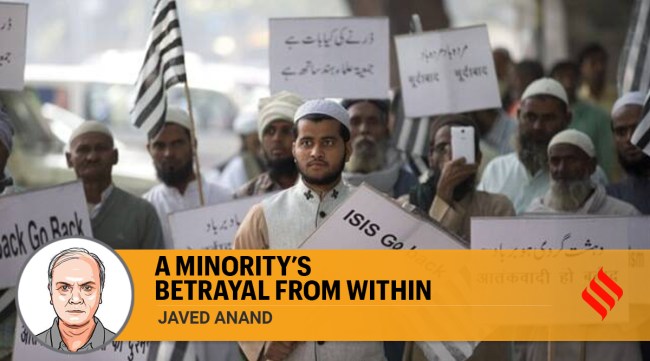Opinion Journey of the Indian Muslim: A betrayal from within
Another India’ challenges academics such as Mushirul Hasan, Ashutosh Varshney, Pratap Bhanu Mehta and Ramachandra Guha in whose works the Nehru years come across as a “golden age” for Indian Muslims
 The book presents data to argue that the marginalisation of the minority community began under the watch of Prime Minister Jawaharlal Nehru. (Express Photo)
The book presents data to argue that the marginalisation of the minority community began under the watch of Prime Minister Jawaharlal Nehru. (Express Photo) Historian Pratinav Anil’s just published book, Another India: The Making of the World’s Largest Muslim Minority, 1947-77, is sure to stir up a hornet’s nest. In itself, the mass of fresh material presented by the author is an eye-opener. Since the release of the Sachar Committee report in 2006 it is public knowledge that Indian Muslims have been the victims of institutionalised discrimination. Now, Another India challenges academics such as Mushirul Hasan, Ashutosh Varshney, Pratap Bhanu Mehta and Ramachandra Guha in whose works the Nehru years come across as a “golden age” for Indian Muslims.
The book presents data to argue that the marginalisation of the minority community began under the watch of Prime Minister Jawaharlal Nehru. But this much Anil grants to India’s “secular colossus”: “True, efforts were made by Nehru to keep the barbarians at bay, but the Hindu nationalists could not be simply wished away. For, time was on their side”. He could have added that thanks to the pernicious Two-Nation Theory, Muslims who were 24.3 per cent of the total population in undivided India were reduced to just 9.8 per cent after Partition. This self-inflicted wound made the task of the Hindu nationalists easier.
No doubt, the Congress must answer for the tragic tale of Indian Muslims even while Nehru was at the helm. But the problem with Anil is that he overstates his case. In so doing, he ends up being inconsistent and self-contradictory. For perspective, missing from the entire book is even a passing mention of the simple fact that no democracy is born perfect where words (Constitution) match deeds (politics) from Day One. What of a country where democracy had such a bloody birth?
Consider, for example, these propositions: “There was never a good time to be a Muslim in postcolonial India, unless one was the right kind of Muslim”; “For the qaum, to echo Dickens, it was the best of times (for the Muslim elite, the Ashraf), it was the worst of times (for the Pasmanda Muslims, the Ajlaf and the Arzal)”; “Indeed, if there is a single takeaway here, it is the simple observation that it was first and foremost class, and not confession, that counted in postcolonial India”. In fact, an entire chapter is devoted to detailing how the state took good care of the “notables” (read political and religious elite) among the Muslims. How, then, do these propositions mesh with the author’s contention that the Indian state behaved like “an Islamophobic agency”?
Consider this, too. The author quotes Jinnah, writing in March 1940, following the adoption of the “Pakistan Resolution” at the Muslim League’s Lahore Conference: “It is a dream that the Hindus and Muslims can ever evolve a common nationality… They are not religions in the strict sense of the word, but are in fact different and distinct social orders … indeed they belong to two different civilisations”. Anil notes: “Throughout the forties, Jinnah talked of ‘Islamic democracy’, an oxymoronic turn of phrase whose constructive ambiguity he exploited in full measure”.
Notwithstanding Jinnah’s oft quoted Pakistan-will-be-a-secular-state speech of August 11, 1947, less than two years later, the Pakistan Constituent Assembly passed the ‘Objectives Resolution’ to affirm: “Sovereignty over the entire universe belongs to Allah Almighty and the authority which He has delegated to the state of Pakistan, through its people, for being exercised within the limits prescribed by Him, is a sacred trust”. Months later, in November 1949, an overwhelmingly Hindu-dominated Constituent Assembly adopted a secular Constitution for India, guaranteeing equality, justice, liberty, fraternity to all citizens irrespective of caste, community… The religious and cultural rights of minorities were also protected. Call this Islamophobia?
Anil has problems with the fact that the Indian Constitution contained no political safeguards for Indian Muslims such as separate electorates, reservation of parliamentary seats, proportional representation. For him, adoption of the first-past-the-post electoral system was nothing but “the handmaiden of majoritarianism”. Could Anil be serious: Separate electorates, religion-based political reservation, in a secular polity?
Admittedly, though, the experience of parties coming to power with 32 per cent of total votes, because of a disproportionate equation between percentage of votes polled and seats won in recent decades underscores the need for revisiting the pros and cons of the first-past-the-post system vis-à-vis that of proportional representation.
Anil suggests that the “essentially-Hindu” party steamrolled the first-past-the-post option in the Constituent Assembly out of devious design. This, even as he concedes that such a choice “dovetailed with contemporary political science orthodoxy, which held that assertive minorities, for they were feared, inevitably generated majoritarian backlash; better, then, to work from within larger parties and institutions”.
The inconsistencies and contradictions notwithstanding, Another India lays equal emphasis on not one but the “double betrayal” of the Muslim masses. Betrayal by the Congress compounded by the betrayal from within: The “Ashraf (political and religious elite) betrayal”. The Ashraf betrayal rested on three pillars: Reposing faith in the “essentially Hindu” Congress, clinging on to an out-of-date, backward-looking sharia, and “disdain for mass politics”.
The book records how, pre-Independence, the anti-colonialism of the nationalist Muslims “was not grounded in an economic critique of imperialism, as was the case with a number of other nationalists from Naoroji to Nehru… they spoke in a language of Islamic millenarianism”. To them, “Muslim India was to be an imperium in imperio (Islamic state within a secular state), with separate (sharia) courts, tax authorities (notional zakat), and rulers (amir-e-hind)”. Among the nationalist Muslims, there was little to choose between the Mr and the Maulana: “Indeed, in the thirties, it was hard to tell apart a ‘socialist’ Congress Muslim from a Maulana”.
Post-independence, “So it was that from 1950 on, Muslim politics became synonymous with the defence of not one but two holy books: the Quran and the Constitution”. Ironically, what continues to be defended, till date, in the name of the Quran — the Muslim male’s right to triple talaq, polygamy and halala, unequal inheritance rights for men and women, hijab, Muslims’ right to child marriage, death for the blasphemer — has little to do with the holy text. It’s a tragic tale of wounds self-inflicted.
The writer is convener, Indian Muslims for Secular Democracy and co-editor, Sabrang India online





